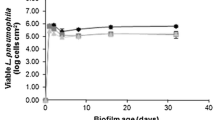Abstract
In the ecology of Legionella pneumophila a crucial role may be played by its relationship with the natural flora; thus we investigated the interactions between Legionella and other aquatic bacteria, particularly within biofilms. Among 80 aquatic bacteria screened for the production of bacteriocin-like substances (BLSs), 66.2% of them were active against L. pneumophila. The possible effect of some of these aquatic bacteria on the development and stability of L. pneumophila biofilms was studied. Pseudomonas fluorescens, the best BLS producer, showed the greatest negative effect on biofilm formation and strongly enhanced the detachment of Legionella. Pseudomonas aeruginosa, Burkholderia cepacia, Pseudomonas putida, Aeromonas hydrophila, and Stenotrophomonas maltophilia, although producing BLSs at different levels, were less active in the biofilm experiments. Acinetobacter lwoffii did not produce any antagonistic compound and was the only one able to strongly enhance L. pneumophila biofilm. Our results highlight that BLS production may contribute to determining the fate of L. pneumophila within ecological niches. The interactions observed in this study are important features of L. pneumophila ecology, which knowledge may lead to more effective measures to control the persistance of the germ in the environment.


Similar content being viewed by others
References
American Public Health Association (1995) Standard methods for the examination of water and wastewater, 19th edn. American Public Health Association, Washington, DC, pp 953–964
Atlas RM (1999) Legionella: from environmental habitats to disease, pathology, detection and control. Environ Microbiol 1:283–293
Borella P, Montagna MT, Romano-Spica V et al (2004) Legionella infection risk from domestic hot water. Emerg Infect Dis 10:457–464
Borella P, Guerrieri E, Marchesi I, Bondi M, Messi P (2005) Water ecology of Legionella and protozoans: environmental and public health perspectives. Biotechn Annu Rev 11:355–380
Brook I (1999) Bacterial interference. Crit Rev Microbiol 25:155–172
Emtiazi F, Shwartz T, Marten SM, Krolla-Sidenstein P, Obst U (2004) Investigation of natural biofilms formed during the production of drinking water from surface water embankment filtration. Water Res 38:1197–1206
Fields BS (1996) The molecular ecology of legionellae. Trends Microbiol 4:286–290
Guerrieri E, Bondi M, Ciancio C, Borella P, Messi P (2005) Micro and macromethod assays for the ecological study of Legionella pneumophila. FEMS Microbiol Lett 252:113–119
Guerrieri E, Bondi M, Borella P, Messi P (2007) Influence of aquatic microorganisms on Legionella pneumophila survival. New Microbiol 30:247–251
Héchard Y, Ferraz S, Bruneteau E, Steinert M, Berjeaud JM (2005) Isolation and characterization of a Staphylococcus warneri strain producing an anti-Legionella peptide. FEMS Microbiol Lett 252:19–23
Heng BH, Goh KT, Ng DL, Ling AE (1997) Surveillance of legionellosis and Legionella bacteria in the built environment in Singapore. Ann Acad Med Singapore 26:557–565
Kekessy DA, Piquet JD (1970) New method for detecting bacteriocin production. Appl Microbiol 20:282–283
Knee M (2000) Selection of biocides for use in floral preservatives. Postharvest Biol Technol 18:227–234
Koide M, Saito A, Kusano N, Higa F (1993) Detection of Legionella spp. in cooling tower water by the polymerase chain reaction method. Appl Environ Microbiol 59:1943–1946
Mampel J, Spirig T, Weber SS, Haagensen JA, Molin S, Hilbi H (2006) Planktonic replication is essential for biofilm formation by Legionella pneumophila in a complex medium under static and dynamic flow conditions. Appl Environ Microbiol 72:2885–2895
Messi P, Guerrieri E, Bondi M (2002) Survival of Aeromonas hydrophila SB14 in an artificial mineral water microcosm. Water Res 36:3410–3415
Messi P, Guerrieri E, Bondi M (2003) Bacteriocin-like substance (BLS) production in Aeromonas hydrophila water isolates. FEMS Microbiol Lett 220:121–125
Messi P, Guerrieri E, Bondi M (2005) Antibiotic resistance and antibacterial activity in heterotrophic bacteria of mineral water origin. Sci Tot Environ 346:213–219
Padilla C, Brevis P, Lobus O, Hubert E (1996) Bacteriocin activity of Pseudomonas sp. on enteropathogenetic bacteria in an artificial aquatic system. Lett Appl Microbiol 23:371–374
Steinert M, Hentschel U, Hacker J (2002) Legionella pneumophila: an aquatic microbe goes astray. FEMS Microbiol Rev 26:149–162
Storey MV, Långmark J, Ashbolt NJ, Stenström TA (2004) The fate of legionellae within distribution pipe biofilms: measurement of their inactivation and detachment. Water Sci Technol 49:269–275
Storey MV, Ashbolt NJ, Stenström TA (2004) Biofilms, thermophilic amoebae and Legionella pneumophila—a quantitative risk assessment for distributed water. Water Sci Technol 50:77–82
Vervaeren H, Temmerman R, Devos L, Boon N, Verstraete W (2006) Introduction of a boost of Legionella pneumophila into a stagnant-water model by heat treatment. FEMS Microbiol Ecol 58:583–592
Author information
Authors and Affiliations
Corresponding author
Rights and permissions
About this article
Cite this article
Guerrieri, E., Bondi, M., Sabia, C. et al. Effect of Bacterial Interference on Biofilm Development by Legionella pneumophila . Curr Microbiol 57, 532–536 (2008). https://doi.org/10.1007/s00284-008-9237-2
Received:
Accepted:
Published:
Issue Date:
DOI: https://doi.org/10.1007/s00284-008-9237-2



